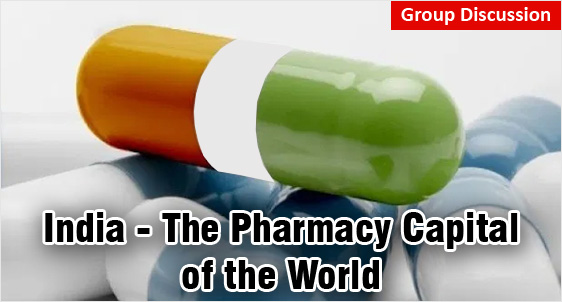
India is often termed as the Pharmacy of the World. However, given the rise of Corona Virus Wave 2, from the ‘pharmacy of the world’ to the ‘epicentre of the coronavirus pandemic’, India’s fall has been dramatic. In the GD Topic, MBAUniverse.com explores how India became a global Pharma giant, and what it needs to do to maintain its position.
Also Read
Let’s start with some numbers that prove India’s global stature.
Government’s Pharma Vision
The Union Cabinet has given its nod for the amendment of existing Foreign Direct Investment (FDI) policy in the pharmaceutical sector in order to allow FDI up to 100% under the automatic route for manufacturing of medical devices subject to certain conditions.
The drugs and pharmaceuticals sector attracted cumulative FDI inflow worth US$ 16.86 billion between April 2000 and September 2020 according to the data released by Department for Promotion of Industry and Internal Trade (DPIIT).
Some of the recent developments/investments in the Indian pharmaceutical sector are as follows:
Indeed, above achievements are commendable for Indian pharma sector. However, there has been criticism too.
From the ‘pharmacy of the world’ to the ‘epicentre of the coronavirus pandemic’,
From the ‘pharmacy of the world’ to the ‘epicentre of the coronavirus pandemic’, India’s fall has been swift and dramatic. Newspapers across the world have criticised India as the second wave of the pandemic unfolds.
During the first wave in 2020, India was better off than countries such as Italy, the United States, and Brazil. India’s handling of the pandemic in 2020 won praise and was a pleasant surprise. Thanks partly to a strict lockdown and perhaps because of its demographic advantage, India managed much better than even developed countries. India played true to its strength as the ‘pharmacy of the world’, sending medicines and vaccines to many countries, thus winning goodwill and praise globally.
However, the second wave of the pandemic in 2021 has caught India unawares. The epic proportion of the tragedy has affected India’s international reputation at several levels.
First, the second wave has exposed the limitations of our health infrastructure (the result of years of inadequate allocation by successive governments), raising questions about the domestic capabilities. India spends just over 1 percent of its GDP on public health, a far cry from the 16 percent spent by the US and 10 percent by Japan, Canada, France, Germany, and Switzerland.
Second, questions are being asked about the advisability of sending vaccines and medicines abroad without ensuring domestic supplies first. Third, with India putting restrictions on exports of vaccines and medicines, other countries may face shortfalls in their supplies and could accuse India of being an undependable supplier. German Chancellor Angela Merkel’s rather un-empathetic statement that the European Union ‘allowed’ India to become such a large pharmaceutical producer and her concern about what could happen if supplies do not reach the West reflects the unhappiness of countries which have relied on Indian supplies.
Finally, the longest-term damage to India’s reputation will depend on how badly the pandemic affects India’s economy and its potential to provide basic needs to its populace. If it fails to do this, it could say goodbye to its dreams of becoming the next great power. India has already had to accept assistance from abroad despite its 2004 policy of not taking such help.
But some positives amidst all this. Perhaps, it is India’s generosity which has led to the outpouring of help from so many countries with leaders like the US President Joe Biden tweeting that “India was there for us, and we will be there for them” recalling India’s generosity to the US when it was facing a crisis.
The pandemic should teach India a valuable lesson: the absolute necessity to prioritise its needs and become the pharmacy capital of the world – which we are truly capable of becoming.
Also Check Latest Group Discussion GD Topics
Exam 2024 Notification